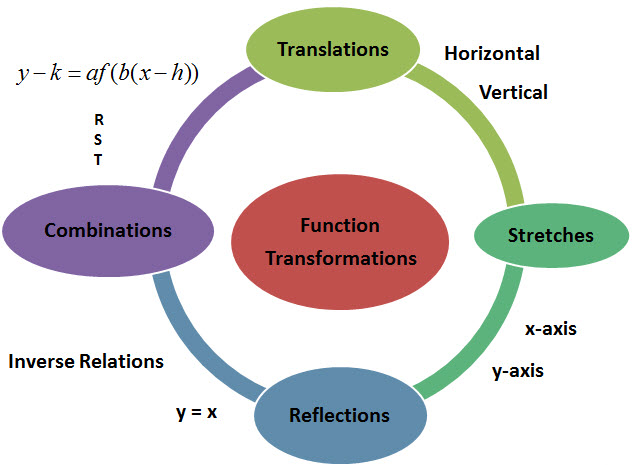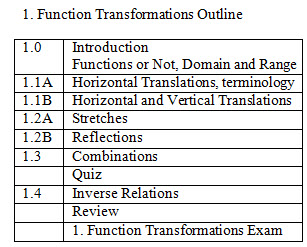1. Function Transformations
Resources for 1. Transformations
| Site: | ARPDC |
| Course: | ERLCMath 30-1, 2012-2014 - Stephanie MacKay (Click to Enter) |
| Book: | 1. Function Transformations |
| Printed by: | Guest user |
| Date: | Thursday, 4 December 2025, 2:33 AM |
Table of contents
- 1. Function Transformations
- 1.1 Horizontal and Vertical Translations
- Formative assessment
- 1.2 Reflections and Stretches
- Stretches formative assessment
- reflections formative assessment
- 1.3 Combining Transformations
- Combinations formative assessment
- 1.4 Inverse of a Relation
- inverses formative assessment
- 1. Transformations of Functions Review
1. Function Transformations


Assessment Standard and Exemplars from Alberta Education have changes. Check out the new standards here.
1.0 Introduction to Functions
Class Notes
The McGraw-Hill Ryerson PreCalculus 12 Text is used as the Main Resource.
Assignments in the Powerpoint Lesson Plans refer to pages and questions in the PreCalculus 12 text.
Digital Resources to Support Visualization and Differentiate Instruction
Nspire Activities:
Many of the concepts in Math 30-1 include functions. The TI Nspire activity Function or Not a Function is a review of what makes a relation a function. This is a teacher led activity involving teacher/student discussion.
Send the TI Nspire files to student handhelds or diplay the file with the computer Document Player.
Function or Not a Function Nspire Activity
Function Notation Nspire Activity
Domain and Range is an important concept when working with functions. It's also a difficult concept for some students to understand. Since students have seen this concept in previous math classes, my teaching approach is to allow students to tap into their prior knowledge and become more active learners.
![]()
Domain and Range Nspire Activity
Domain and Range Student Activity Worksheet
Web Links:
1.1 Horizontal and Vertical Translations
Class Notes
The McGraw-Hill Ryerson PreCalculus 12 Text is used as the Main Resource.
Assignments in the Powerpoint Lesson Plans refer to pages and questions in the PreCalculus 12 text.
![]() 1.1B Horizontal and Vertical Translation
1.1B Horizontal and Vertical Translation
Digital Resources to Support Visualization and Differentiate Instruction
![]()
Pedagogical Shifts: TRANSFORM, Moving from Traditional to Student-centered
Shifting from Student as Knowledge Recipient to Student as Inquirer and Creator
Shifting from Memorization to Higher-level Thinking
Shifting from Competitive to Collaborative Learning
I wanted to begin my jouney of transforming my teaching and student learning by taking steps to move students away from lecture style learning. I presented the idea of horizontal transformations in my usual style of presentation with powerpoint notes and digital resources (1.1A Family of Functions above) for students to visualize the mathematics. They had a good grasp of the concept and were able to explain the effect on the graph of a parent function when the parameter h in y = f(x - h) was changed. They understood that y = f(x - 3) meant a translation of the graph of a function three units to the right. The next step in my lesson was to teach the effect of vertical translations and the image function equation (the effect of k). Rather than teaching in the same lecture and digital visualization style, I decided to TRANSFORM. Students were placed in groups of two or three. The problem asked was open ended and went something like this..."Does the function equation for a vertical translation behave in the same manner as a horizontal translation?" Students must provide algebraic proof of their findings.
Students were reluctant as first since many of them had only experienced math in a lecture style. Students began by asking questions... What letter do I use for the transformation? Where does the parameter go in the function equation? They wanted to be told what to do but this is not supporting higher-level thinking nor does it support student as inquirer and creator. I reponded to students by asking them questions. Is the letter used important? What would you like to use? What letters should not be used? It was interesting how students directed their own learning once they found out that I was not going to tell them what to do.
Once students were finished with their algebraic proof of their understands, they did a gallery walk to see what other groups had done. At the end of the activity we summarized vertical translations.
What did I learn from my students???? They were able to discover the effect of k on the graph of a function in BOTH forms y - k = f(x) and y = f(x) + k.
1.2 Reflections and Stretches
Class Notes
The McGraw-Hill Ryerson PreCalculus 12 Text is used as the Main Resource.
Assignments in the Powerpoint Lesson Plans refer to pages and questions in the PreCalculus 12 text.
Digital Resources to Support Visualization and Differentiate Instruction
1.3 Combining Transformations
Class Notes
The McGraw-Hill Ryerson PreCalculus 12 Text is used as the Main Resource.
Assignments in the Powerpoint Lesson Plans refer to pages and questions in the PreCalculus 12 text.
![]() 1.3 Combining Transformations (new)
1.3 Combining Transformations (new)
Digital Resources to Support Visualization and Differentiate Instruction
The GSP (Geometer's Sketchpad) File below is from the McGraw-Hill Ryerson PreCalculus 12 DVD teacher digital resource. (This file is copyright.)
Students will be able to investigate when the order of transformations is important in obtaining the correct image graph.

1.4 Inverse of a Relation
Class Notes
The McGraw-Hill Ryerson PreCalculus 12 Text is used as the Main Resource.
Assignments in the Powerpoint Lesson Plans refer to pages and questions in the PreCalculus 12 text.
Digital Resources to Support Visualization and Differentiate Instruction
Restrict the Domain Sample Video
TI Nspire Files
**Note: The Math 30-1 Assessment Standards and Exemplars Draft 2012-2013 from Alberta Learning states Reflections in the line y = x should not be combined with any other transformations.